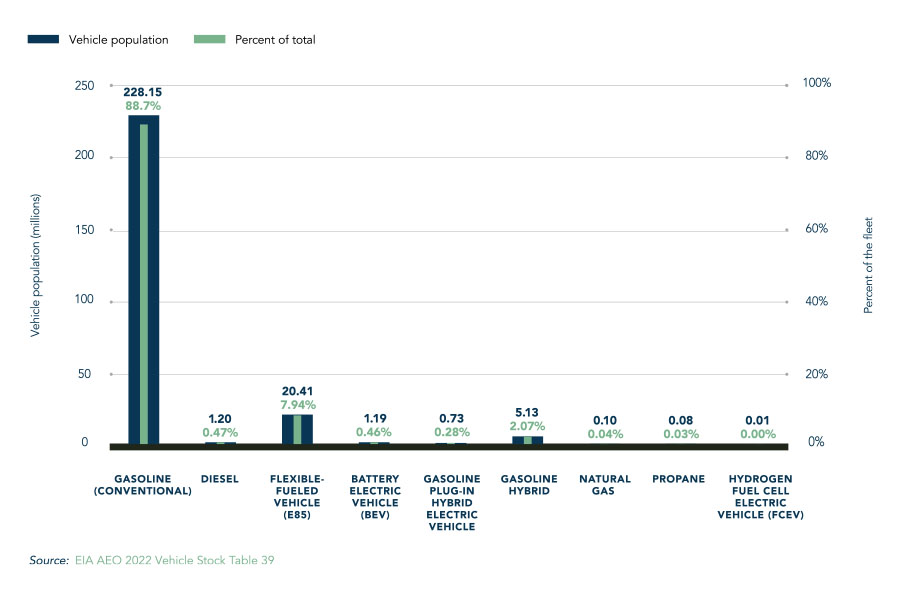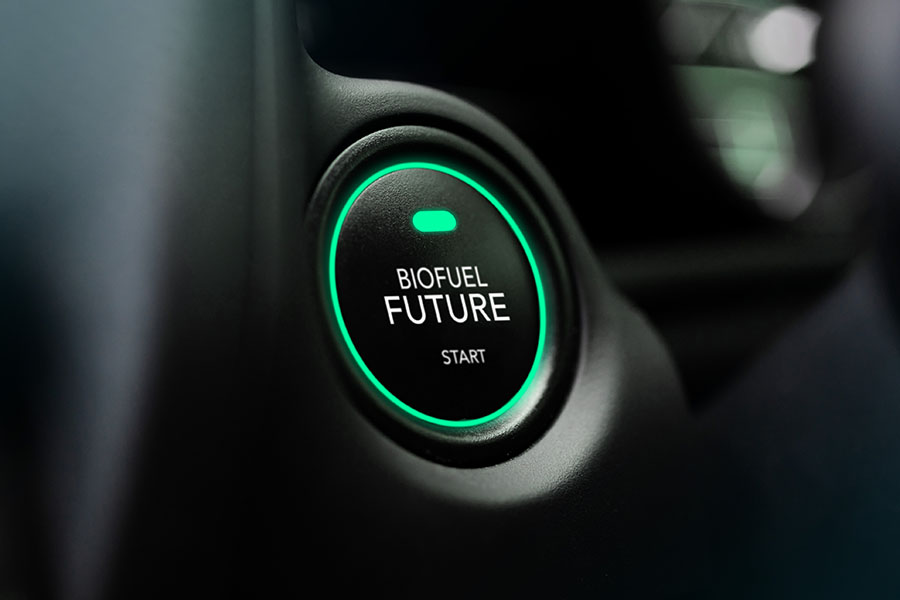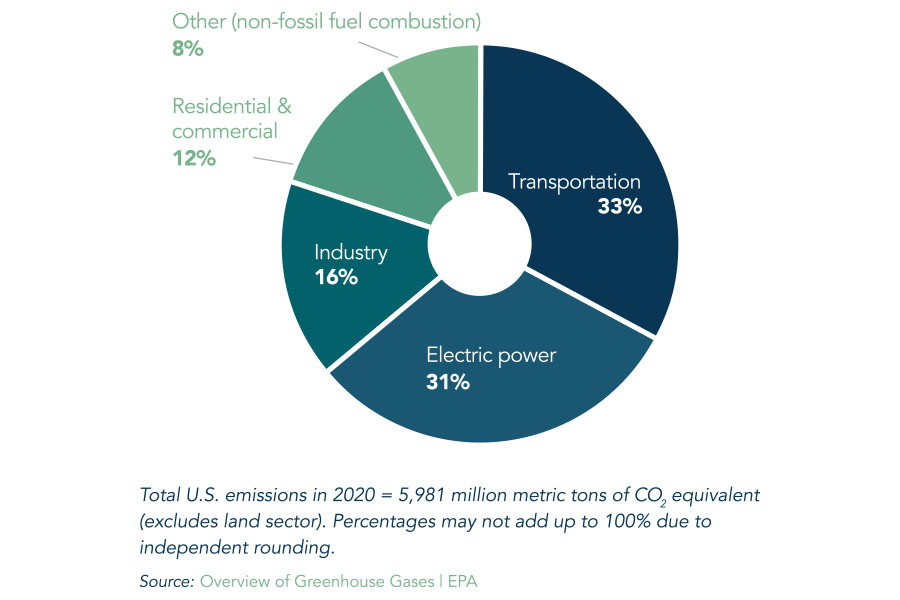“We must move from climate procrastination to climate activation. And we must do it today."
–UNEP Executive Director Inger Andersen remarked on the Climate Change 2023: Synthesis Report from the Intergovernmental Panel on Climate Change
The consensus from the international science community is clear; the Paris Agreement calls for a reduction in emissions of 45 percent by 2030 and net zero by 2050.
Which begs the question: Why in the area of transportation — the largest carbon-emitting sector of the United States — do we hesitate to take the obvious step of dramatically increasing biofuel use to improve engines on the road today? And why is the nation’s attention so narrowly focused on electric vehicles (EVs), which will take decades to reach a meaningful level of use?
Internal combustion engine vehicles (ICEVs) are the dominant vehicles in the U.S. and across the world, and they will continue to be so for the foreseeable future, according to a recent study from the Transportation Energy Institute, a non-advocacy research organization. Improving emissions in these vehicles alongside growth in EVs is crucial to succeeding in our emission-reduction goals — and higher biofuel blends, like E15, will play a critical role.
Light duty vehicle population and percent of total for fuel types and technologies
Fleet penetration
The study, called Decarbonizing Combustion Vehicles, notes that as of 2022, 98.7% of the U.S. light-duty fleet is powered by gasoline blends (conventional, gasoline-hybrids, and Flex Fuel Vehicles).
Of the new cars sold today, half will still be on the road in 16 years, said John Eichberger, Executive Director of Transportation Energy Institute, citing data from Oak Ridge National Laboratory.
That same source also notes that with the current fleet turnover rate, it will take 29 years for new vehicles to replace all of the vehicles sold in 2021.
“So you start putting that in context, and we're supposed to have a net zero economy by 2050. Those vehicles need to have a lower-carbon fuel. Otherwise, there's no chance we're going to meet our target,” Eichberger said.
In addition, the focus on new vehicles excludes a large number of people. Many in the U.S. cannot afford to purchase new vehicles, and internationally, that’s even truer.
“You can bring in new technology, and that's awesome, and we should continue doing that. But if you don't take care of the core product, which is the one and a half billion combustion engines on the road in the world, where are you going to go?” he said. “And let's say the United States could go all-electric, and let's say we could green the grid. What about Africa? What about Latin America? What about Australia? What about the Far East? There are communities within our country and in the world that cannot do this anytime soon. And so we need solutions for all of them, too.”
Reducing emissions with EVs and biofuels
Comparing emissions between EVs and ICEVs is difficult. EV emissions vary depending on the source of electricity. But overall, the study found them comparable to biofuels.
“Today’s ICEV fleet emissions are approaching EV emission rates, and ICEV emissions will continue to be reduced into the future as the ICEV fleet gets cleaner and more fuel efficient,” the study states.
The case for using biofuels is clear, said Doug Berven, POET Vice President of Corporate Affairs. It works, and it works in today’s engines. Global bioethanol production reduces greenhouse gas emissions by 100 metric tons annually, the equivalent of taking 20 million cars off the road, he said. Higher blends like E15, which is already available to consumers, could reduce greenhouse gas emissions even further.
“That's significant. And the fact that we can increase blend ratios of bioethanol and reduce emissions while reducing the price of gasoline with an already available product — I mean, it just makes total sense,” he said. “Why would we not expand the use of biofuels for those reasons? We can do that today. We don't have to wait years and years for the market to adopt a new technology.”
On the policy front, states are beginning to recognize the benefits and need for biofuels like E15.
“E15 is a high-performance biofuel blend made from Midwest-grown corn that is compatible with nearly every car, truck, and SUV on the road today,” said Joshua Shields, POET Senior Vice President of Corporate Affairs. “It’s an American-made fuel that brings big benefits to rural communities, Midwest economies, and farm families.”
Eichberger said the key to emission reduction is continued innovation along the supply chain.
“You can reduce carbon emissions even further at the bioprocessing facility. You can reduce carbon emissions in the distribution chain. You can reduce the carbon emissions on rail transport. You reduce carbon emissions in truck transport and pipeline operations, and you start layering those benefits throughout the life cycle, and you start seeing a real, meaningful impact,” he said.
Many solutions
It is going to take a multi-faceted approach to solve our climate problems, Eichberger said. Biofuels will play an important role, as will EVs and even other solutions that might not be viable yet today.
“It really comes down to the fact that we have options,” he said. “Some of them are near-term, some of them are longer-term. Some of them have technical challenges. Some of them have economic challenges.”
To be successful, we must stay focused on the goal rather than governments picking favorites.
“What you've just done is you've completely taken the scientists and engineers and shut them out of the lab,” he said. “That’s the worst thing we can do. We have got some really smart people in this world that have solved problems for hundreds of years.”
Broadly, Berven sees an increasing role for agriculture in solving our world’s energy problems.
“The reality is agriculture and biofuels are going to play a major, major part of any climate mitigation policy going forward, and that's being recognized by world leaders all over the world,” Berven said. “We know that by agriculture's role at COP 28 in Dubai; it was everywhere. It is being realized that agriculture holds the greatest potential solution to decarbonization.”
More specifically, the U.S. needs to increase the availability and use of E15, he said. Many states are putting policies in place to do so, but more work must be done.
Cumulative GHG reductions from biofueled ICEVs vs. EVs
U.S. anthropogenic CO2 emissions by source (1990-2020)
“Eight bipartisan Midwestern Governors have championed year-round E15 in their respective states and succeeded in expanding access to affordable biofuels across the Midwest,” said Shields. “E15 reduces America’s reliance on foreign oil, cuts emissions, and lowers prices at the pump. Access to higher blends of biofuel is common sense, is impactful, and we can do it today.”
Progress on those solutions is important, Eichberger said. ICEVs are simply too prevalent and last too long to be ignored when talking about the “now” problem of climate change and emission reductions. That fact is what motivated this research.
“[ICEVs] are going to continue to have a huge market share; they're going to be a great part of the economy. We can’t overlook them as a viable, readily available solution to our transportation needs. And biofuels are continuously proving themselves to be the low-carbon, liquid fuel key to decarbonizing the transportation sector.”












